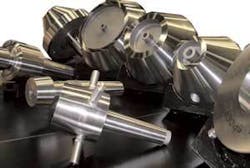Separator designed for refinery waste water treatment
Enviro Voraxial Technology Inc., Fort Lauderdale, Fla., has delivered a Voraxial 2000 separator to Resource Environmental Group Services LLC (REGS), Commerce City, Colo., for use in refinery waste water stream treatment.
One of the initial applications REGS will focus on with the Voraxial is to improve waste water systems, specifically ahead of API separators. REGS is working with a refinery customer and several engineering firms to develop a water treatment system built around the Voraxial separator.
The continuous flow separator simultaneously separates liquid/liquid, liquid/solid, or liquid/liquid/solid mixtures at high flow rates while achieving high levels of purity, the company says. The separator produces a real-time, high “g” centrifugal force to yield high-purity product at a volume of 3 gpm to more than 10,000 gpm.
Source: Enviro Voraxial Technology Inc., 821 NW 57th Pl., Fort Lauderdale, FL 33309.
Heavy-duty bull ring rotating mandrel
Here’s a rotating mandrel with a selection of interchangeable bull rings from 5 in. to 54 in. in diameter. The company says its centering device is engineered to handle the turning, threading, and grinding of thick-walled downhole/through-hole shafts used in the energy industry.
The product is available live for conventional tail stocks, and also in a dead center configuration for live tail stocks. The rings can be changed out without removing the mandrel from the tail stock. Extra heavy duty bearings and robust spindle design help provide high rigidity and guaranteed ring accuracy of ±0.0002 in. TIR.
Source: Riten Industries Inc., 1100 Lakeview Ave., Washington Court House, OH 43160.
Free arc welding safety CD
A new arc welding safety CD (MC06-209), yours free for the asking, features industry and product news, including the new US Occupational Safety & Health Administration hexavalent chromium standards and OSHA’s small entity compliance for hexavalent chromium standard. Visit www.lincolnelectric.com for the CD.
The new standard lowers OSHA’s permissible exposure limit (PEL) for hexavalent chromium, and for all Cr(VI) compounds, to 5 µg of Cr(VI) per cubic meter of air as an 8-hr time-weighted average.
The new standard requires industries to control worker exposures to Cr(VI) so the new PEL is not exceeded.
Source: Lincoln Electric Co., 22801 St. Clair Ave., Cleveland, OH 44117.



